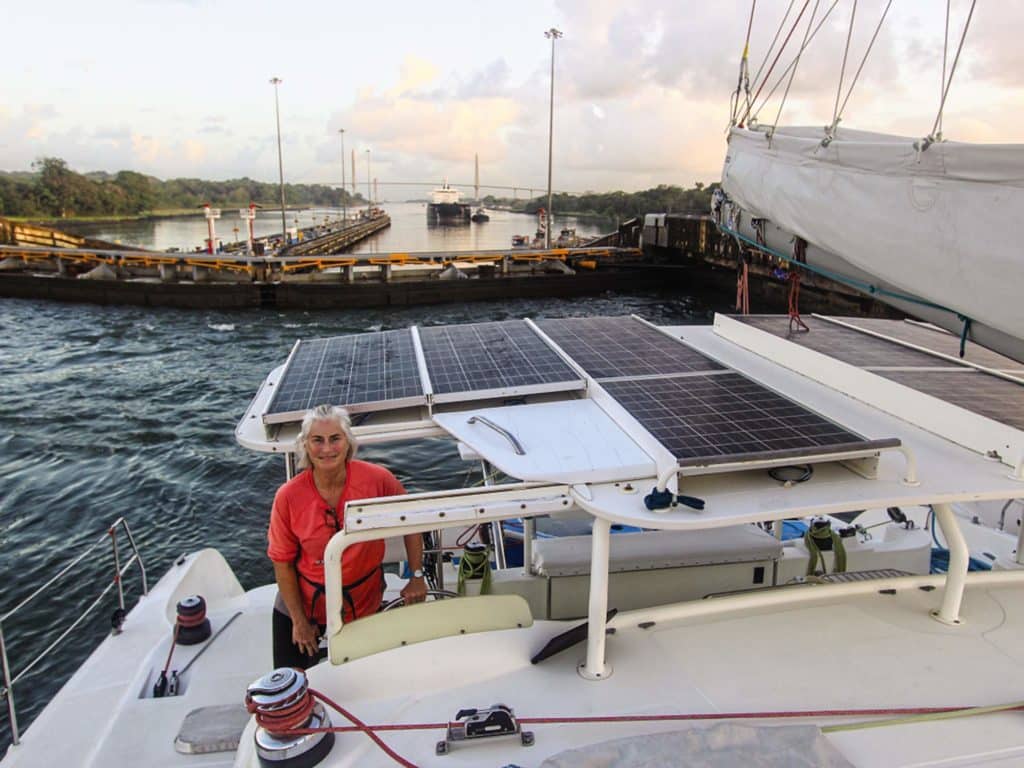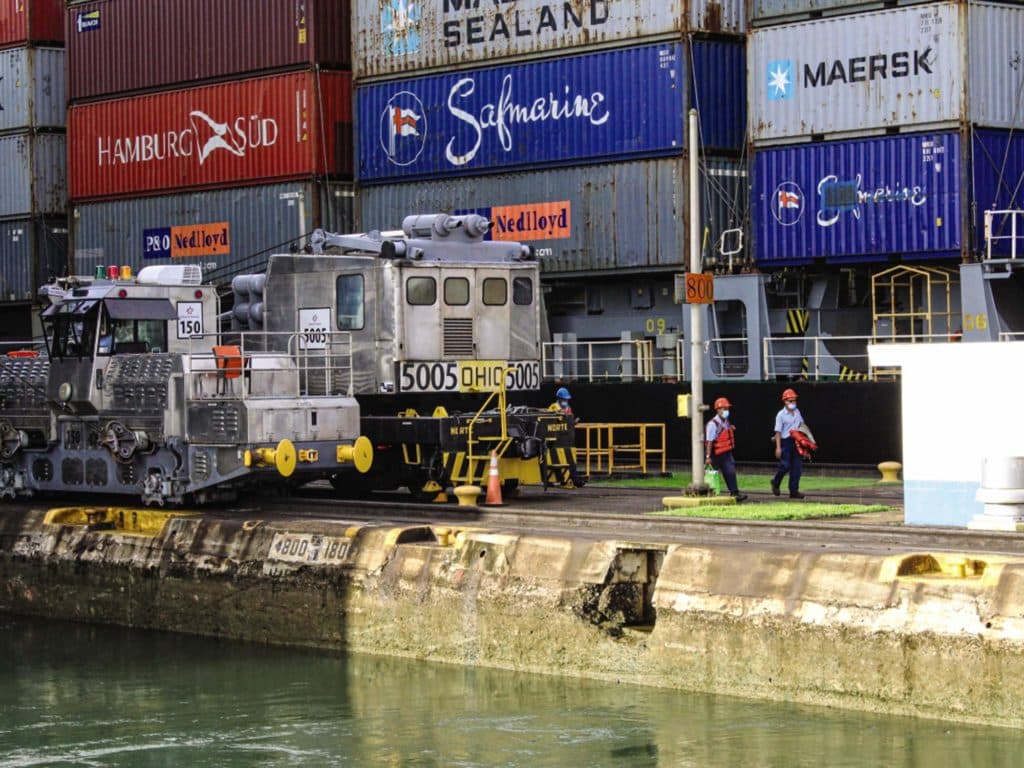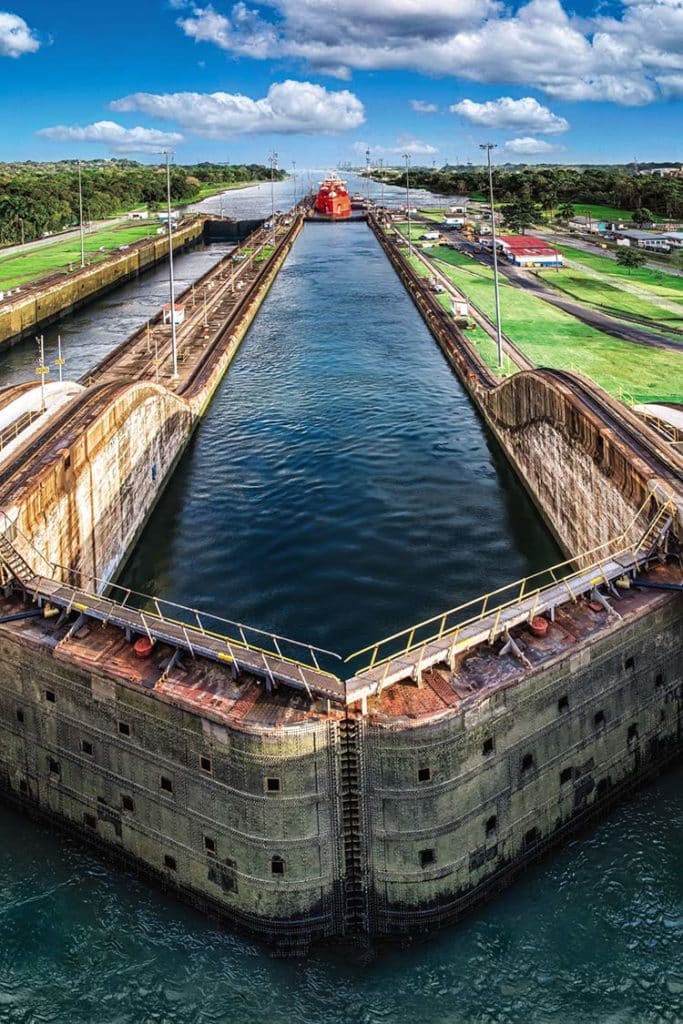
Me, go around Cape Horn? Seriously? Do I want to brave roaring, high-latitude gales just to earn an earring in my left ear?
Um, no.
When Harriet and I decided to trade the Atlantic for the Pacific, we kept Cape Horn at the bottom of our bucket list, especially because there’s a safe, enjoyable, fascinating way to swap the Atlantic for the Pacific that doesn’t involve an 8,300-nautical-mile detour. The Panama Canal, a roughly 50-mile-long journey through history, is a cruising milestone that opens up both oceans to long-distance exploration.
Life is short, so why not take the shortcut?
Lots of help
For cruisers reaching the Panama Canal Zone for the first time—as we did in mid-December on our Dolphin 460 catamaran, Ocean, after beginning our transit from Colón, Panama, on the Atlantic side—there’s lots of research and reading to tap into beforehand.
Start with historian David McCullough’s 1977 book, The Path Between the Seas, and follow that with books and websites that look at more-recent developments, such as the 1999 transfer of the canal from the United States to Panama and the 2016 opening of a second set of locks to handle the mammoth Panamax and Neopanamax vessels (up to 1,200 feet length overall, carrying as many as 14,000 20-foot containers).
While you are waiting your turn to transit, we recommend checking out the Agua Clara Visitor Center in Colón or the Miraflores Visitor Center and the Panama Canal Museum on the Pacific side in Panama City, which is a modern, cosmopolitan city.
We had a lot of questions about the requirements and mechanics of transiting the
canal, such as the official admeasurement of our boat (length, beam, draft, tonnage speed under power, and details about our crew and deck equipment), and the line handlers (Panama Canal Authority-supplied crew, your own crew or crew from other cruising boats), and the necessary fenders and lines. There’s lot of help available online, including from the Panama Canal Authority itself, and you’ll no doubt meet other cruisers who have done the trip before.
The Panama Canal operates around the clock 365 days a year, and communication about all aspects of the transit, in these days of email, texts and WhatsApp, is well-organized.
Need an agent?
How’s your Spanish? As first-timers, we contacted a few cruisers who’d been through the canal, and their advice was yes, get an agent for the transit, especially if your command of Spanish is, um, basic.
Our agent, Erick Galvez of Centenario Consulting, proved invaluable. He spoke English well; answered our questions quickly; explained every step of the transit; arranged our canal booking, our admeasurement and line handlers; kept us updated as our time slot drew closer; and helped us with non-canal stuff too.

The transit requires supplying the right documents to the right government official in the right office at the right time, and given the language barrier, there’s a fairly high chance of things getting lost in translation.
Overall, the cost of this enterprise, including the $1,500 transit toll for Ocean—and the transit admeasure, security fee, fenders and lines rental, agent service fee, Panama cruising permit, and one line handler and a pilot/adviser—came to just over $2,900.
Our transit
Before heading for the canal, we spent about 10 days chasing down boat projects at Shelter Bay Marina, a full-service facility a few miles from the canal entrance. Two friends from our late-’80s cruise through the South Pacific, Karen and Paul Prioleau, joined our boat for the transit, so we needed only one more line handler. Our agent arranged for Juan, who was studying to become a canal pilot, to join Ocean, and a Panama Canal Authority pilot boat met us to drop off Roy, our pilot/adviser, as we approached the first lock.
Once we were safely inside the Gatun Locks, the bells of the electric locomotives clanged and the sliding steel sluice gate closed behind us. Twenty-six-million gallons of water flooded in, silently lifting Ocean, along with the 45-foot powerboat we were rafted to, and an imposing container ship, 27 feet above the Atlantic.
Our crew was excited: “How cool is this!” Yes, the Panama Canal is very cool—suddenly you find yourself in the middle of amazing history and modern technology.
The rush of water boiling up in the chamber combined with prop wash from the ship just in front of us was alarming, but Roy had positioned Ocean in the best spot in the lock. It’s safer to be alone, if possible, with your lines keeping you in the center of the lock, or to be rafted to another yacht that is tied to the wall of the canal; avoid nesting to a tug or alongside the wall.

Keep your two bow and two stern lines taut. We rented 125-footers of seven-eighths polypropylene and eight round fenders from the Panama Canal Authority. Be sure to ease the lines to avoid a high upward load that could snap your cleats.
We found that the counter-rotating props of our cat’s twin 40 hp diesels helped Harriet adjust our position as needed; the prop walk of a monohull’s single screw will require more anticipation by your line handlers. In any case, your pilot/adviser and local line handlers are experienced (Roy and Juan had each transited more than 1,000 times) with all kinds of boats.
Once released from the three Gatun Locks, most yachts spend the night on an official mooring in Gatun Lake, resuming the transit early the next morning. Swimming from your boat is not allowed, however, because of crocodiles. This shortcut between the seas is also a slash through the jungle: howler monkeys, which are pint-size creatures swinging through the canopy, let loose a roar that sounds like an 18-wheeler, while jaguars and pumas pad through the rainforest.
Oh, and if you transit during the May-to-November rainy season, it likely will be pouring: Panama receives 12 feet of annual rainfall. The timing of our one-day transit was a bit unusual, beginning at 0430 and finishing by 1700, so we missed the overnight stay among the crocs and jaguars and howler monkeys. We missed the rain too.
The rest of the transit was easy. The interoceanic waterway eases into long, winding stretches, including cuts through mountain ranges that were won at a tremendous cost in human life—an estimated 25,000 people perished from tropical diseases and industrial accidents during the canal’s 1880 to 1914 construction. Just two final sets of locks—the Pedro Miguel and the Miraflores—and the canal dropped us into the Pacific.
Well worth it
History and politics weigh heavily upon the Panama Canal, but for cruisers, the experience is equal parts educational and magical.
More than 100 years ago, the ditch was dug with steam-powered diggers and men with shovels. Some of yesteryear’s leading-edge technology, such as the line-handling electric locomotives running on both sides of the locks, are still operating today. The canal’s million-dollar tugboats with omnidirectional propulsion are present-day cutting-edge. The six new Panamax locks are a showcase of engineering and construction; the colossal project consumed more than 1.5 billion cubic feet of concrete and 192,000 tons of steel reinforcement. The Panama Canal has functioned in spectacular fashion from its opening in 1914.
Our transit of the Panama Canal was memorable—a milestone for Harriet, me and Ocean. It’s also difficult to sum up. As McCullough wrote, “The 50 miles between the oceans were among the hardest ever won by human effort and ingenuity, and no statistics on tonnage or tolls can begin to convey the grandeur or what was accomplished.”
For cruisers, it is all that, of course—plus it’s a fantastic shortcut. And worthy of an earring in your starboard ear.
As of press time, Tom and Harriet Linskey were headed to the Marquesas.








